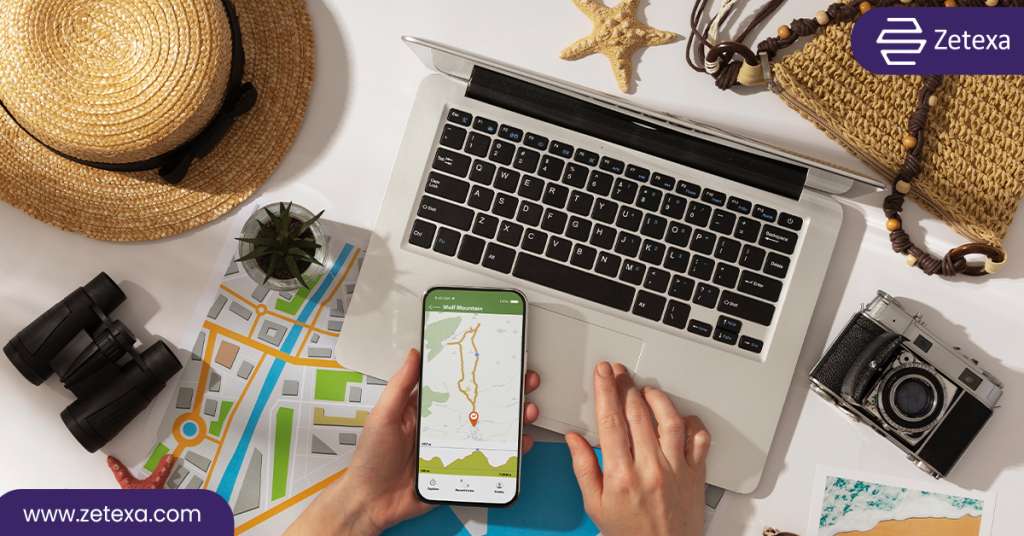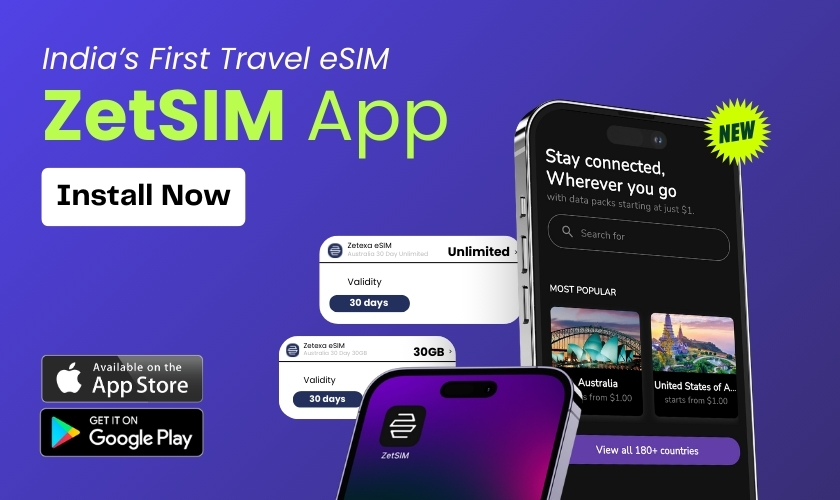Why is an eSIM the Best SIM Card for Overseas Travel?
Travelling abroad has become a need nowadays for global communication. Many people make it a point to remain connected when traveling, whether for work or play. Advancements in mobile technology make the eSIM, with the potential to revolutionize, possible.
This blog seeks to solve the puzzles around eSIM technology. It explores its benefits, drawbacks, and general usefulness for travellers. eSIMs provide more ease, flexibility, and seamless cross-border communication. They serve as an alternative to regular physical SIM cards. Discover how the eSIM cards are much better than the regular SIM cards for overseas travel. Explore the digital connection to see whether eSIMs provide a smooth travel experience.
eSIM Technology
So, before starting, you might have some questions in your mind. Like what is an eSIM card, and how does an eSIM work? Let us learn about it.
A digital replacement for the physical SIM cards often seen in mobile devices is an eSIM. An eSIM is installed right into the device’s hardware, compared to a regular SIM card that may be removed. The eSIM technology removes the need for a physical card. It results in a more simplified and flexible mobile connection management solution.
For the eSIM to function, subscriber data, like operator profiles and credentials, must be stored on a secure integrated chip. This chip is within the gadget. The mobile network provider may provide and activate this data. It saves consumers from having to exchange SIM cards when switching carriers physically. The eSIM enables activating and managing cellular connections more quickly and easily. It can be done over the phone without a physical SIM card replacement.
Aside from making the activation process easier, eSIMs allow profiles to be used on a single device. Consumers may switch between several cell plans or providers on a smartphone with an eSIM. This can be done according to their requirements or preferences. eSIM technology benefits customers who need to connect to many networks on a single device. This is due to its adaptability.

Benefits of eSIMs for International Travel
eSIMs offer many advantages for international travelers. It makes them a simple alternative to regular physical SIM cards for overseas travel. The following are some benefits of traveling abroad using an eSIM:
- Global Connectivity: eSIMs remove the need to swap physical SIM cards. They provide access to several mobile networks across international borders. This guarantees constant, smooth international connection.
- Remote Activation: Users may set up their mobile service before they arrive at their location. They can remotely activate their eSIMs. Doing this may save time when facing language obstacles or strange local customs.
- Convenience and Flexibility: Users may move between cell plans or providers by storing several profiles on a single eSIM. Those who go to various areas regularly may find this helpful flexibility.
- No Physical SIM Swapping: When switching networks, eSIMs remove the physical SIM card swapping or replacement need. This removes the possibility of physical SIM cards for overseas travel being misplaced.
- Cost Efficiency: Certain eSIM providers offer affordable international roaming options. This is in comparison to regular SIM cards for overseas use. It might lower roaming expenses for travelers. Local eSIM payments are another option available to those who want affordable access.
- Space Saving: Because eSIMs replace actual SIM card slots, brands can create more compact phones. When travelling, this is helpful for those who want to reduce the weight and size of their devices.
- Easy Management through Apps: Through specialised smartphone applications, users can easily manage their eSIM profiles. They can also check data use, add more plans, and monitor expenses. Travelers on a tight budget can particularly benefit from this degree of control.
- Improved Security: By permitting remote deactivation in loss or theft, eSIMs improve security. Due to their integrated design, eSIMs are less prone to physical harm or unauthorized removal.
- Fast Network Switching: Network switching is fast and often possible at anytime. This is useful for travelers who may need to cross many countries quickly.
- Suitable for a Range of Devices: Smartwatches, tablets, smartphones, and other connected gadgets increasingly use eSIM technology. This offers a uniform and standardized approach to global networking.
The advantages of eSIM cards for overseas travel are expected to grow. It develops and becomes popular, providing consumers with more convenient and affordable choices.
eSIM cards vs. Regular SIM Cards
The basic function of both regular SIM cards and eSIM cards is to identify and verify users on mobile networks. But, their physical form, activation mode, flexibility, and applications vary. The differences between eSIM and regular SIM cards for overseas travel are:
- Physical Form:
- Regular SIM Cards: These are real, detachable cards that fit into slots into compatible devices. They are available in regular, micro, and nano sizes.
- eSIM Cards: They are inserted into the device during the making and cannot be removed or changed.
- Activation Process:
- Regular SIM Cards: To activate, the user must put the SIM card into the device and follow the instructions. It might need manual setup and take a while.
- eSIM Cards: Activation may be completed remotely via a smartphone app or a QR code that the carrier provides. This makes the activation process faster and more smooth.
- Flexibility
- Regular SIM Cards: Changing phones or using several devices with the same number is made simpler. They allow users to transfer SIM cards between devices physically.
- eSIM Cards: Physical switching is restricted by their embedded nature. Customers can maintain several profiles on the same device. It can move between various plans or providers without swapping out physical cards.
- Device Design and Size:
- Regular SIM Cards: Devices must include a slot for a real SIM card. It might affect the size and design of the device.
- eSIM Cards: Devices may be made more compact and more water-resistant since there is no need for a physical slot.
- Travelling abroad:
- Regular SIM Cards: Changing SIM cards in person or buying local SIM cards are common ways to roam globally. Users may need to unlock their phones to use the SIM card from a different carrier.
- eSIM Cards: Users may remotely activate an overseas plan. They can also switch to a local carrier without physically swapping SIM cards.
- Security:
- Regular SIM Cards: It is possible to remove physical SIM cards. It might increase the risk of theft or illegal usage.
- eSIM Cards: Because the SIM cannot be easily removed, its embedded design offers protection.
- Adoption and Compatibility:
- Regular SIM cards: They are widely used and accepted by most devices and service providers worldwide.
- eSIM cards: They are becoming more widely used. But, carrier and geographic support vary. Not every carrier or device may be able to use eSIM technology.
eSIM cards provide greater design options and better support for many profiles. It has a more efficient activation process than regular SIM cards for overseas. The normal SIM card only offers physical flexibility. Device compatibility, personal preferences, and the specific use case all play important roles.
Tips for Optimising eSIM Usage Abroad
Using an eSIM might help you remain connected when traveling overseas. Here are a few tips for managing your eSIM use.
- Research Local Carriers: Locate local carriers in the target country that use eSIM technology before traveling. This may help you choose the most cost-effective and secure choice.
- Compare plans: Compare eSIM plans from several carriers to see which meets your data, speak time, and messaging requirements. Consider coverage, data speed, and foreign roaming charges.
- Before departure, activate your eSIM: Before you leave your home country, activate your eSIM and choose your chosen plan. This assures you a functional connection when you arrive at your location.
- Backup Traditional SIM: If your device accepts physical and eSIM cards, consider storing your conventional SIM card as a backup. If there are any problems with the eSIM, you may use the regular SIM card to stay connected.
- Check device compatibility: Ensure the phone is compatible with eSIM technology and unlocked so you can utilise local carrier services effortlessly.
- Save QR codes: Save the eSIM QR codes sent by your carrier. These QR codes are required to activate your eSIM, and saving them makes it simpler to adjust or set up your eSIM if necessary.
- Understand roaming policies: Understand the roaming regulations of both your home carrier and your local carrier. Some carriers may provide lower international roaming charges or agreements that allow you to save money.
- Monitor data usage: Keep track of your data usage to prevent facing unexpected costs. Most smartphones provide built-in capabilities for monitoring data use. In addition, several carriers offer applications or web portals where you may track your consumption.
- Use Wi-Fi When Available: Use Wi-Fi networks wherever available to save data and reduce roaming expenses. Many locations, including hotels, cafés, and public venues, provide free or paid Wi-Fi services.
- Turn Off Data Roaming When Not Required: Switch it off when not using data roaming to prevent excessive data costs. When you are not actively utilizing data services, turn your smartphone to airplane mode or deactivate data roaming.

The search for eSIMs as an international travel solution shows many advantages. This makes them a popular choice for modern travelers. Travelers from outside will find no greater simplicity than not having to physically exchange SIM cards and being able to handle various profiles on a single device. The convenience of using eSIM technology is increased by not having to deal with conventional physical SIM cards. It also gives the option to activate or cancel programs remotely. The ZetSIM app is a great choice for anyone looking for a smooth and easy experience. The app guarantees that travellers worldwide stay connected no matter where they travel. It has wide coverage, which spans more than 180 countries.
Global travelers expect eSIMs to meet their expectations in a world where connection is essential. Say hello to the future of travel, and forget about switching SIM cards for overseas adventure. Let the reliability and simplicity of eSIMs be your constant travel companion as you set off on your next foreign trip. It will ensure that you remain connected no matter where your adventures take you.

Download the ZetSIM App from App Store
Download the ZetSIM App from Google Play store
FAQs
Cost-effectiveness depends on use habits and carrier plans, so weighing your alternatives before deciding is crucial.
Ease of use evaluation is important since activation procedures differ, particularly when switching between carriers when traveling.
Adoption varies, so it’s important to check device compatibility and the availability of eSIM plans in your abroad trip.



